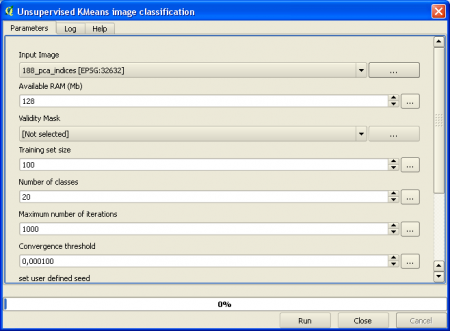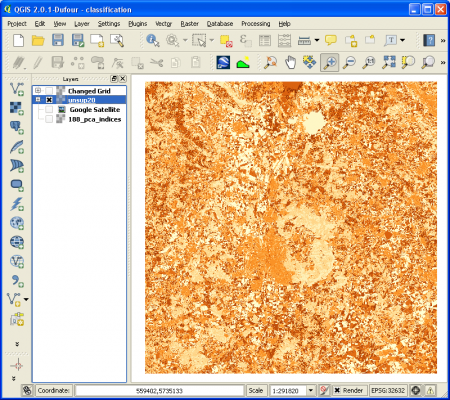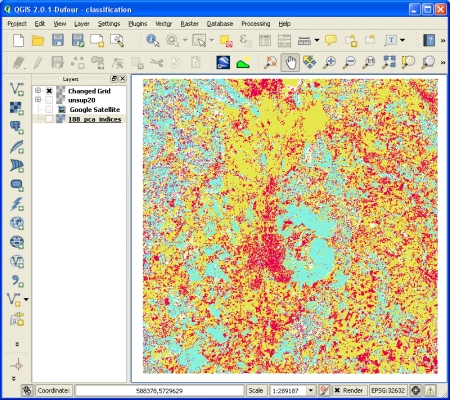Unsupervised classification (Tutorial)
From AWF-Wiki
(Difference between revisions)
| Line 48: | Line 48: | ||
## Open the k-means classification algorithm provided by the Orfeo toolbox. It can be found in the processing toolbar under {{mitem|text=Toolbox --> Orfeo Toolbox --> Learning --> Unsupervised KMeans image classification}} (see figure '''A'''). | ## Open the k-means classification algorithm provided by the Orfeo toolbox. It can be found in the processing toolbar under {{mitem|text=Toolbox --> Orfeo Toolbox --> Learning --> Unsupervised KMeans image classification}} (see figure '''A'''). | ||
##* Set the ''188_pca_indices'' layer as {{button|text=Input image}}. | ##* Set the ''188_pca_indices'' layer as {{button|text=Input image}}. | ||
| + | ##* Training set size: 100000 | ||
##* Set the {{button|text=Number of classes}} to 20 and the {{button|text=Number of iterations}} to 1000. | ##* Set the {{button|text=Number of classes}} to 20 and the {{button|text=Number of iterations}} to 1000. | ||
##* The {{button|text=Convergence threshold}} should be set at 0.0001. | ##* The {{button|text=Convergence threshold}} should be set at 0.0001. | ||
Revision as of 13:21, 12 December 2016
- In this article, you will learn how to classify a landscape raster via k-means clustering
| Code | Name | Cluster number | RGB color |
|---|---|---|---|
| 1 | Urban area | 10,9,15 | 230-000-077 |
| 2 | Cropland | 16,0,13,3,7,17,18 | 255-255-168 |
| 3 | Pastures/grassland | 12,8 | 230-230-077 |
| 4 | Broadleaved forest | 6,2,5,4 | 128-255-000 |
| 5 | Coniferous forest | 11,19 | 000-166-000 |
| 6 | Water bodies | 14 | 128-242-230 |
| 7 | Cloud | 1 | 255-255-255 |
- Classifying an image
- Add the raster layer 188_pca_indices.tif into a QGIS project. It should be available in the course data (see previous exercise).
- Open the k-means classification algorithm provided by the Orfeo toolbox. It can be found in the processing toolbar under Toolbox --> Orfeo Toolbox --> Learning --> Unsupervised KMeans image classification (see figure A).
- Set the 188_pca_indices layer as Input image.
- Training set size: 100000
- Set the Number of classes to 20 and the Number of iterations to 1000.
- The Convergence threshold should be set at 0.0001.
- Leave all other configurations as they are and click Run. The resulting image has 20 classes, labeled from 0 to 19.
- Image symbology
- Right-click the classified layer in the TOC and select Properties --> Style (see figure B).
- Set the Render type to Singleband pseudocolor.
- Set Color interpolation to Discrete.
- In the Load min/max section, select the Min/max radio button and click Load to update the range for classification.
- Set the Mode to Equal interval with 20 classes and confirm with Classify.
- Confirm with Apply or click OK if you are content with your settings.
- Create a land use/cover classification scheme table as in table A.
- As a reference, you may add a google layer to the project:
Web --> ObenLayers plugin --> Add Google Satellite layer. - Set the coordinate reference system
- Open Project --> Project properties.
- Set WGS 84 Pseudo Mercator (EPSG 3857) as coordinate system
- Check the Enable on the fly transformation box
- Right click 188_pca_indices in the TOC and select Set Project CRS from layer.
- Order the maps in the TOC so that the classified layer lies above the Google Maps layer.
- Now, zoom in to some section of the classified layer where the classes can easily be distinguished.
- Activate and de-activate the layer in the TOC and compare to the Google layer in order to get an idea of the classes.
- While doing so, create a table displaying which classes in the classified layer may represent the classes in table A. You can write it down on a sheet of paper or save it as a text file on your computer.
- As a reference, you may add a google layer to the project:
- Change the grid values
- Select Saga --> Grid-Tools --> Change grid values from the Processing toolbox.
- As Grid, select the output map from the previous step.
- From the Replace condition pulldown menu, select [2] Low value <= grid value < high value.
- Now, open the lookup menu table (...) and enter the values you have written down in the previous step.
- Set path and name of the output file and launch the algorithm with Run.
- Select Saga --> Grid-Tools --> Change grid values from the Processing toolbox.
- Assign discrete colors to the land cover layer (figure C).
- Right click the layer in the TOC or double click to open the layer Properties.
- Select the Style tab and set the following options:
- For Render type select Singleband pseudocolor
- For Color interpolation, select Discrete
- Set Mode to Equal interval and Classes to 7.
- Set Load min/max values to Min/max.
- For better interpretation, you can edit the Label column in the classes section according to the class names in table A.
- Don't forget to click Classify for adding the classes.
- Click Load and confirm with Apply or OK.
Figures
 Figure A: Dialogue of the Unsupervised K-Means image classification plugin from the Orfeo toolbox in QGIS. |
|

